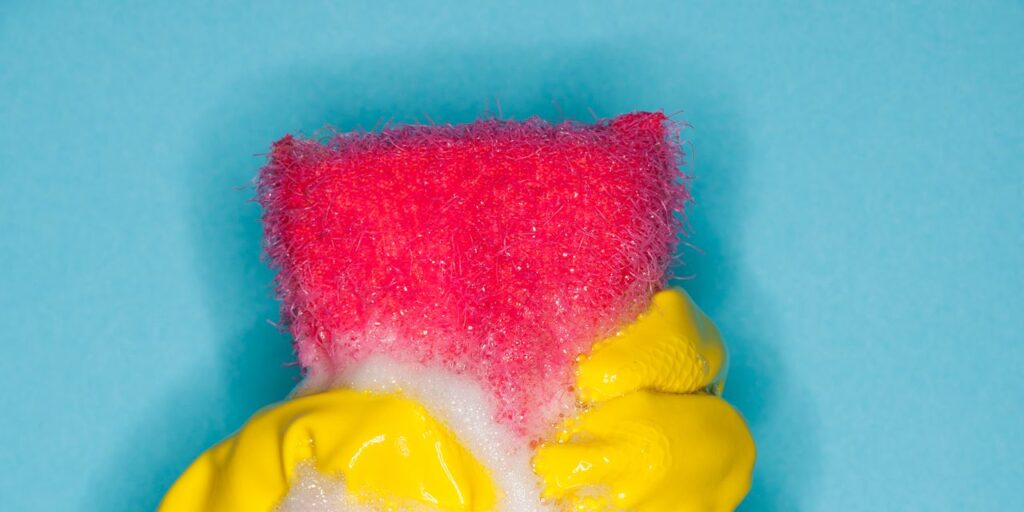The good news is that you can successfully disinfect your sponges through a handful of methods—like wetting and microwaving it on high for a minute if it doesn’t have a metal scouring pad, or running it through your dishwasher using the heated dry setting, he says. And there are a couple steps you can take to minimize the amount of bacteria on it, like by never leaving a sponge in a dirty sink or near where food prep is happening, and keeping it dry when you’re not using it.
Even with all these precautions in place, he says it’s still a good idea to plan to replace your sponge every seven to 10 days rather than waiting for it to change color or smell funky. “The longer you use an unclean sponge, the higher your risk of catching or spreading an infection, [and] a worn-out sponge is not as effective in removing food and grease from dirty dishes,” Sullivan explains.
7. And you use the same sponge for everything.
Using the same sponge to wipe down a sink and a countertop is a recipe for mess, says Tetro, which is why he encourages keeping up to three sponges handy at once for various purposes. “One for regular dishwashing, one for pre-washing to get off grease and oil and sauces, and one for disinfecting, [which] can also be used for rinsing surfaces,” he says.
If three sponges seems like a lot to use at the same time, consider following the popular two-sponge rule instead, which involves reserving one for washing dishes and cleaning up organic material (like leaked chicken juices), and the other for washing and disinfecting surfaces—that way you’re not accidentally spreading potentially harmful foodborne bacteria onto your freshly cleaned counters. So whether you choose to use two or three sponges at once, the important takeaway is this: Never contaminate your disinfecting sponge.
8. You don’t clean your fridge after removing moldy food.
Refrigerators slow the decay of food, but as much as it would be appreciated, they don’t stop it entirely, Dr. Sullivan says. “That’s why fruits and vegetables in the fridge still get moldy and meats still rot—it just takes longer than if they sat at room temperature,” he explains.
When this does happen, he notes that there’s also a risk that bad food can cross-contaminate your still-good food if not disposed of quickly. We’ve all encountered a fruit or veggie that, though once firm, is now soft and mushy and seeping some kind of foreign, malodorous liquid all over the place. He says that simply wiping it up isn’t enough, and that spot cleaning the affected area after such an occurrence is necessary for ensuring no harmful bacteria remain or spread. But your best bet is to give the whole shelf a scrub down if you want to be extra safe.
Remove all food, shelves, and drawers, rinse the removable items with hot, soapy water to remove residual slime, before finally treating with a disinfectant and letting it soak for the amount of time recommended by the manufacturer’s instructions. Wipe down the rest of the fridge with a commercial or homemade bleach disinfectant, then dry completely with a paper towel.
9. You focus on counters—and forget about touch-points.
Even if you always remember to wipe down your counters, you might be forgetting some major real estate: Cabinet, fridge, oven, and sink handles and faucets plus light switches and anywhere you’re touching frequently end up being some of the germiest places in the kitchen based solely on how much traffic they get, says Tetro. What’s more, they’re at the root of a lot of cross-contamination that happens in the kitchen. Think about it: If the handle of your fridge or dishwasher is dirty, the bacteria from it can inevitably spread to any clean dishes or ingredients you take out of it.


